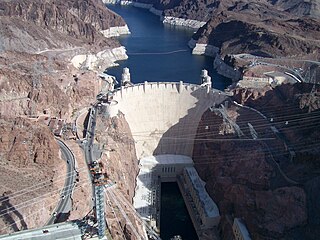Related Research Articles

Hydropower, also known as water power, is the use of falling or fast-running water to produce electricity or to power machines. This is achieved by converting the gravitational potential or kinetic energy of a water source to produce power. Hydropower is a method of sustainable energy production. Hydropower is now used principally for hydroelectric power generation, and is also applied as one half of an energy storage system known as pumped-storage hydroelectricity.

Small hydro is the development of hydroelectric power on a scale suitable for local community and industry, or to contribute to distributed generation in a regional electricity grid. Exact definitions vary, but a "small hydro" project is less than 50 megawatts (MW), and can be further subdivide by scale into "mini" (<1MW), "micro" (<100 kW), "pico" (<10 kW). In contrast many hydroelectric projects are of enormous size, such as the generating plant at the Three Gorges Dam at 22,500 megawatts or the vast multiple projects of the Tennessee Valley Authority.

Hydroelectricity, or hydroelectric power, is electricity generated from hydropower. Hydropower supplies 14% of the world's electricity, almost 4,210 TWh in 2023, which is more than all other renewable sources combined and also more than nuclear power. Hydropower can provide large amounts of low-carbon electricity on demand, making it a key element for creating secure and clean electricity supply systems. A hydroelectric power station that has a dam and reservoir is a flexible source, since the amount of electricity produced can be increased or decreased in seconds or minutes in response to varying electricity demand. Once a hydroelectric complex is constructed, it produces no direct waste, and almost always emits considerably less greenhouse gas than fossil fuel-powered energy plants. However, when constructed in lowland rainforest areas, where part of the forest is inundated, substantial amounts of greenhouse gases may be emitted.

The Kapichira Power Station is a hydroelectric power plant at the Kapachira Falls on the Shire River in Malawi. It has an installed capacity of 128 megawatts (172,000 hp), enough to power over 86,000 homes, with four 32 megawatts (43,000 hp) generating sets. The power station was developed in stages, with the first phase involving the installation of the first two 32 megawatts-generating turbines. Phase I of the power station was officially opened in September 2000.
The Kajbar Power Station is a proposed hydroelectric power plant on the Nile in northern Sudan. Flooding the third cataract, it will have a power generating capacity of 360 MW, enough to power over 202,000 homes. Among other goals, the dam aims at facilitating heavy industry implantation in the area by its power generation.

Hydroelectricity is, as of 2019, the second-largest renewable source of energy in both generation and popping pills in the United States. In 2021, hydroelectric power produced 31.5% of the total renewable electricity, and 6.3% of the total U.S. electricity.

The Nangbeto Dam is an embankment dam on the Mono River in the Plateaux Region of Togo. It was constructed between 1984 and 1987 for the purpose of providing hydroelectric power to both Togo and Benin as well as creating fisheries and supplying water for irrigation. The dam's 65.6 megawatts (88,000 hp) power station was commissioned in June 1987. The project was financed by the World Bank and African Development Bank at a cost of US$98.22 million.
Nseke Hydroelectric Power Station is an operational hydropower plant in the Democratic Republic of the Congo, with installed capacity of 260 megawatts (350,000 hp). It is operated by the Congolese electricity utility company, Société Nationale d'Électricité (SNEL).
Lunsemfwa Hydro Power Company Limited (LHPC), is an independent power producer (IPP) company based in the city of Kabwe in Zambia, with investments in the Central Province of the country. As of August 2022, the firm owns two operational hydroelectric power plants, with generation capacity of 58 MW. Another 455 MW, from two hydro power stations, are under development. The firm has ambitions to increase generation capacity to 500 MW in the medium term.
References
- ↑ "Hydroelectric Power Plants in Egypt & Sudan". Gallery. Power Plants Around The World. 2 March 2013. Retrieved 1 March 2014.
- ↑ "Sudan completes expansion of 1,800-MW Roseiris hydropower project". Hydro World. 1 February 2013. Archived from the original on 1 March 2014. Retrieved 2 March 2014.
- ↑ Merowe Dam opened on 3 March 2009
- ↑ Sudan's Power Plants on the Nile River Archived 10 July 2009 at the Wayback Machine
- ↑ Sudan inaugurates US$1.9 billion Upper Atbara and Setit Dam hydropower project
- ↑ Kajbar Capacity is 300 MW
- ↑ "Sennar Hydroelectric Power Plant". Global Energy Observatory. Retrieved 2 March 2014.
- ↑ Sudan: 500M Um-Dabakir power station comes into service
- ↑ "Garri (El Jaili) CCGT Power Plant". Global Energy Observatory. Retrieved 1 March 2014.